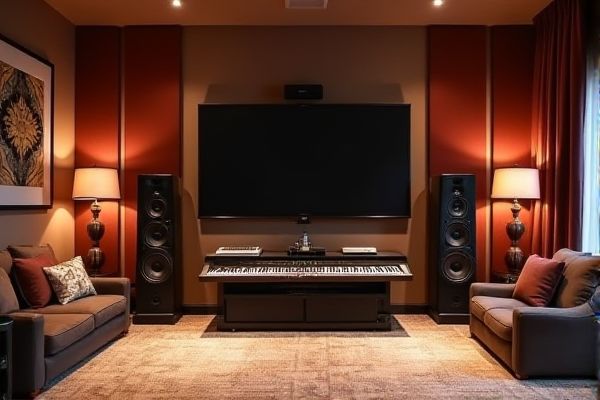
A home recording studio is designed for capturing and producing high-quality audio with acoustic treatment and specialized equipment, while an AV room focuses on optimal audio and video playback for entertainment purposes. Discover the key differences and learn how to tailor each space to Your specific needs by reading the rest of the article.
Table of Comparison
| Feature | Home Recording Studio | AV Room |
|---|---|---|
| Primary Purpose | Audio recording and production | Audio and video playback |
| Acoustic Treatment | High-quality soundproofing, acoustic panels, bass traps | Moderate sound absorption, focus on sound clarity |
| Equipment | Microphones, audio interfaces, monitors, DAW software | Speakers, TV/projector, AV receiver, streaming devices |
| Room Design | Optimized for recording isolation and sound accuracy | Designed for immersive audio-visual experience |
| Lighting | Adjustable, professional lighting for recording | Dim or ambient lighting for viewing comfort |
| Typical Users | Musicians, podcasters, audio engineers | Home theater enthusiasts, casual viewers |
| Space Requirements | Compact, sound-isolated space preferred | Larger area for seating and screen setup |
| Sound Quality Focus | Recording clarity and mixing accuracy | Balanced sound with surround or stereo options |
Introduction to Home Recording Studios and AV Rooms
Home recording studios are dedicated spaces designed for music production, equipped with microphones, audio interfaces, and digital audio workstations to capture and edit high-quality sound. AV rooms focus on optimal audio-visual experiences, featuring soundproofing, surround sound systems, and large displays to enhance cinematic viewing and multimedia presentations. Both environments require acoustic treatment, but home studios prioritize sound isolation for precise audio capture, while AV rooms emphasize sound distribution for immersive playback.
Key Differences Between Home Studios and AV Rooms
Home recording studios prioritize sound isolation, acoustic treatment, and high-quality audio equipment to capture clear, professional-grade recordings, while AV rooms focus on optimal playback experiences with calibrated speakers and immersive sound systems. The studio environment is designed to minimize noise and reflections for precise sound capture, whereas AV rooms emphasize speaker placement, room acoustics, and visual components for enhanced entertainment or presentation. Your choice depends on whether you need precise audio production or a space primarily for audio-visual enjoyment.
Design and Layout Considerations
Design and layout considerations for a home recording studio prioritize acoustic treatment, sound isolation, and ergonomic placement of equipment to ensure optimal audio quality and workflow. AV rooms focus more on comfortable seating, speaker placement for immersive sound, and screen positioning to enhance visual and auditory experiences. Your space should balance soundproofing and functional layout depending on whether the primary goal is recording precision or media consumption.
Essential Equipment Comparison
A home recording studio requires essential equipment such as a digital audio interface, studio monitors, microphones, headphones, and a computer with DAW software for high-quality sound capture and production. In contrast, an AV room prioritizes audiovisual components including a large display or projector, surround sound speakers, AV receiver, and media players for optimal playback experience. While both setups use audio equipment, the home recording studio focuses on sound creation and editing tools, whereas the AV room emphasizes immersive audio-visual playback hardware.
Acoustic Treatment: Studio vs AV Room
Acoustic treatment in a home recording studio prioritizes sound isolation and absorption to capture clear, accurate audio with minimal reflections or external noise, ensuring professional-grade recordings. In contrast, an AV room focuses on optimizing sound for playback, using treatments that balance bass response and reduce echo to enhance the listening experience rather than recording quality. Your home setup benefits from tailored acoustic solutions depending on whether the primary goal is sound creation or immersive sound reproduction.
Cost Analysis: Building a Studio or AV Room
Building a home recording studio typically involves higher initial costs due to specialized acoustic treatment, soundproofing materials, and professional-grade audio equipment compared to an AV room designed primarily for media consumption. Your investment in a studio may include advanced mixing consoles, microphones, and monitors, whereas an AV room focuses more on high-quality speakers, a projector or large display, and comfortable seating. Evaluating ongoing expenses, a recording studio demands regular equipment upgrades and maintenance, while an AV room's costs remain mostly centered around technology refreshes and comfort enhancements.
Sound Quality Performance
A home recording studio is designed with acoustic treatment and specialized equipment to deliver superior sound quality performance, capturing clear and balanced audio for professional-grade recordings. AV rooms prioritize immersive sound experience for playback with optimized speaker placement and room acoustics tailored for media consumption rather than sound capture. Your choice between the two depends on whether you need precision in recording or enhanced audio performance for listening sessions.
Flexibility and Multi-Purpose Use
A home recording studio offers greater flexibility and multi-purpose use, allowing you to produce music, record podcasts, and edit audio in a single, adaptable space. In contrast, an AV room is typically designed for fixed audio-visual playback with optimized acoustics for movie watching and gaming, limiting its functionality for recording tasks. Your choice depends on whether you prioritize creative production versatility or immersive entertainment experiences.
Ideal Users: Musicians vs Audiophiles
Home recording studios cater primarily to musicians who require versatile equipment for recording, mixing, and producing music, with sound isolation and acoustic treatment tailored to creative sound manipulation. AV rooms target audiophiles seeking an optimal listening environment with high-fidelity speakers, precise sound calibration, and minimal acoustic interference to enhance playback quality. Musicians prioritize functionality and multi-instrument compatibility, while audiophiles emphasize superior sound reproduction and immersive audio experience.
Making the Right Choice for Your Needs
Choosing between a home recording studio and an AV room depends on your primary audio goals and space requirements. A home recording studio is optimized for sound isolation, acoustic treatment, and professional-grade equipment to produce high-quality recordings. Your decision should consider whether you prioritize recording fidelity or a versatile environment for media playback and casual listening.
 homyna.com
homyna.com